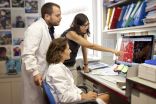INFORMATION:
Water to understand the brain
The detection of aqueous influxes in neurons allows a better deciphering of cerebral functioning
2015-07-02
(Press-News.org) To observe the brain in action, scientists and physicians use imaging techniques, among which functional magnetic resonance imaging (fMRI) is the best known. These techniques are not based on direct observations of electric impulses from activated neurons, but on one of their consequences. Indeed, this stimulation triggers physiological modifications in the activated cerebral region, changes that become visible by imaging. Until now, it was believed that these differences were only due to modifications of the blood influx towards the cells. By using intrinsic optical signals (IOS) imaging, researchers from the University of Geneva (UNIGE), Switzerland, demonstrated that, contrary to what was thought, another physiological variation is involved: the activated neurons swell due to the massive entry of water. This discovery provides evidence that a much finer analysis of the functioning of the brain - and of its dysfunctions - is possible. These results are published in the journal Cell Reports.
Mainly two types of brain imaging techniques are used to determine which cerebral areas are stimulated during a given activity. One of them is functional magnetic resonance imaging (fMRI), which reflects the change of oxygen level and variations of the blood flow in the excited regions. The localization of these areas is based on a phenomenon termed «BOLD» (Blood Oxygen Level Dependant), related to the magnetic properties of hemoglobin, which vary according to its state of oxygenation.
The other technique, named intrinsic optical signals (IOS) imaging, detects modifications of light refraction on cerebral cells in action, by recording a lesser luminous intensity in the activated zones. This method is used as an alternative to functional MRI, in particular when a magnetic field may disrupt the examination. Until now, scientists thought that this modification of light behavior was also due to hemodynamic changes.
An out of line effect
Alan Carleton, professor at the Department of Fundamental Neurosciences of the Faculty of Medicine of UNIGE uses IOS imaging to observe the functioning of the olfactory bulb. «We obtain highly contrasted images in answer to an odor, because thousands of nose sensory cells expressing the same olfactory receptor converge on a very small volume in the brain. We were however surprised to observe that, if the signals are visible immediately after emission of the sensory stimulus, the flow of blood is altered only more than one second later», explains the scientist. The temporal gap is important enough to confirm that, contrary to a well-established consensus, the detected signal has no hemodynamic origin.
What is the cellular origin of the signals? In collaboration with the team of Ivan Rodriguez, professor at the Department of Genetics and Evolution of the Faculty of Science of UNIGE, the electric activity of the various cells involved in response to odors was studied. This was done with mice genetically modified so that each type of cell of the olfactory bulb becomes fluorescent when stimulated. «We did not find any signal related to a change in hemoglobin oxygenation. However, we observed a signal emitted by the sensory neurons themselves, in response to their own electric activity», says the researcher.
The signal of water
What does this signal reflect? The researchers discovered that it is in fact caused by the entry of water into the activated neuron, at the level of its axon, the «cable» through which the electric impulse propagates towards another cell. Besides, they demonstrated that the imaging signal - the flow of water into the axons - is directly coupled with the electric activity. «We observe a mechanical and immediate effect of neuron activation, rather than a modification of the blood flow afterwards, notes Alan Carleton. Thus, we avoid the uncertainties of interpretation of the signals related to the blood flows, which, being delayed and acting more globally on the cerebral region studied, do not exactly reflect the activated area.
Water movements observed thanks to IOS imaging can be also detected by functional MRI. The Genevese scientists provide henceforth the proof of the cellular mechanism at work, thus demonstrating the potential of this method. «Both types of imaging technique converge: observing the movements of water, rather than examining the oxygenation of blood, improves the localization of active neurons and allows to detect potential pathologies. The problem does not lie in the fact of observing a signal, but of determining its origin, to be able to interpret what we see», concludes Ivan Rodriguez.
ELSE PRESS RELEASES FROM THIS DATE:
Commonly prescribed drugs affect decisions to harm oneself and others
2015-07-02
Healthy people given the serotonin-enhancing antidepressant citalopram were willing to pay almost twice as much to prevent harm to themselves or others than those given placebo drugs in a moral decision-making experiment at UCL. In contrast, the dopamine-boosting Parkinson's drug levodopa made healthy people more selfish, eliminating an altruistic tendency to prefer harming themselves over others. The study was a double-blind randomised controlled trial and the results are published in Current Biology.
The research provides insight into the neural basis of clinical disorders ...
ASHG issues position statement on genetic testing in children and adolescents
2015-07-02
BETHESDA, MD - The American Society of Human Genetics (ASHG) Workgroup on Pediatric Genetic and Genomic Testing has issued a position statement on Points to Consider: Ethical, Legal, and Psychosocial Implications of Genetic Testing in Children and Adolescents. Published today in The American Journal of Human Genetics, the statement aims to guide approaches to genetic testing for children in the research and clinical contexts. It also serves as an update to the Society's 1995 statement of the same title, which was issued jointly with the American College of Medical Genetics.
"Twenty ...
CNIO researchers show that telomeres are linked to the origins of idiopathic pulmonary fibrosis
2015-07-02
Idiopathic pulmonary fibrosis (IPF) causes a gradual loss of respiratory capacity and can be lethal within a few years. The cause is unknown, although it can be attributed to a combination of genetics and the environment. A team of researchers from the Spanish National Cancer Research Centre (CNIO) have now discovered that telomeres, the structures that protect the chromosomes, are at the origin of pulmonary fibrosis. This is the first time that telomere damage has been identified as a cause of the disease. This finding opens up new avenues for the development of therapies ...
Melanoma mutation rewires cell metabolism
2015-07-02
A mutation found in most melanomas rewires cancer cells' metabolism, making them dependent on a ketogenesis enzyme, researchers at Winship Cancer Institute of Emory University have discovered.
The finding points to possible strategies for countering resistance to existing drugs that target the B-raf V600E mutation, or potential alternatives to those drugs. It may also explain why the V600E mutation in particular is so common in melanomas.
The results are scheduled for publication in Molecular Cell.
The growth-promoting V600E mutation in the gene B-raf is present in ...
First comprehensive analysis of the woolly mammoth genome completed
2015-07-02
The first comprehensive analysis of the woolly mammoth genome reveals extensive genetic changes that allowed mammoths to adapt to life in the arctic. Mammoth genes that differed from their counterparts in elephants played roles in skin and hair development, fat metabolism, insulin signaling and numerous other traits. Genes linked to physical traits such as skull shape, small ears and short tails were also identified. As a test of function, a mammoth gene involved in temperature sensation was resurrected in the laboratory and its protein product characterized.
The study, ...
New guidelines recommend brain stents to fight strokes in certain patients
2015-07-02
MAYWOOD, Ill. - New devices called stent retrievers are enabling physicians to benefit selected patients who suffer strokes caused by blood clots. The devices effectively stop strokes in their tracks.
For the first time, new guidelines from the American Heart Association/American Stroke Association recommend the treatment for carefully selected patients who are undergoing acute ischemic strokes and who meet certain other conditions.
Loyola University Medical Center stroke specialist Jose Biller, MD, is a member of the expert panel that wrote the guidelines, published ...
NASA looks at Tropical Depression 10W's most powerful storms
2015-07-02
Infrared date from NASA's Aqua satellite spotted the strongest storms within newborn Tropical Depression 10W over the Philippine Sea today, July 2. It is expected to strength to a tropical storm, at which time it will be renamed "Linfa."
A tropical cyclone is made up of hundreds of thunderstorms, and the highest storms are the coldest and most powerful. To identify those areas with the strongest storms, infrared data is used because it tells temperature. The higher the cloud top, the stronger the uplift in a storm and the colder the cloud top temperature will be.
The ...
New measurements reveal differences between stem cells for treating retinal degeneration
2015-07-02
By growing two types of stem cells in a "3-D culture" and measuring their ability to produce retinal cells, a team lead by St. Jude Children's Research Hospital researchers has found one cell type to be better at producing retinal cells.
The research not only reveals which stem cell type might be better for treating retinal degeneration, but it also demonstrates a standardized method for quantifying the effectiveness of different stem cells for such therapies.
The research was led by Michael Dyer, Ph.D., a member of the St. Jude Department of Developmental Neurobiology ...
Working out in artificial gravity
2015-07-02
Astronauts on the International Space Station (ISS) have a number of exercise options, including a mechanical bicycle bolted to the floor, a weightlifting machine strapped to the wall, and a strap-down treadmill. They spend a significant portion of each day working out to ward off the long-term effects of weightlessness, but many still suffer bone loss, muscle atrophy, and issues with balance and their cardiovascular systems.
To counteract such debilitating effects, research groups around the world are investigating artificial gravity -- the notion that astronauts, ...
Changes to the AOU Check-list of North American Birds
2015-07-02
The latest Supplement to the American Ornithologists' Union Check-list of North American Birds was published this week in The Auk: Ornithological Advances, and includes several major updates to the organization of the continent's bird species. More than just a list, the Check-list groups birds into genera, families, and orders based on their evolutionary relationships, and some of the most significant changes in this year's Supplement involve the tanagers, family Thraupidae. "Recent genetic studies have overturned much of what we thought we knew about what constitutes a ...
LAST 30 PRESS RELEASES:
How immune cells communicate to fight viruses
Unveiling the lionfish invasion in the Mediterranean Sea
Scientists regenerate neural pathways in mice with cells from rats
Publicly funded fertility program linked to a decrease in rate of multifetal pregnancy
Cancer survivors reporting loneliness experience higher mortality risk, new study shows
Psychiatric symptoms, treatment uptake, and barriers to mental health care among US adults with post–COVID-19 condition
Disparities in mortality by sexual orientation in a large, prospective cohort of female nurses
National trial safely scaled back prescribing of a powerful antipsychotic for the elderly
Premature mortality higher among sexual minority women, study finds
Extreme long-term research shows: Herring arrives earlier in the Wadden Sea due to climate change
With hybrid brains, these mice smell like a rat
Philippines' counter-terrorism strategy still stalled after 7 years since the ‘ISIS siege’ on Marawi
BU doc honored by the American College of Surgeons
Airborne single-photon lidar system achieves high-resolution 3D imaging
Stem cell transplants and survival rates on the rise across all racial and ethnic groups
Study reports chlamydia and gonorrhea more likely to be treated per CDC guidelines in males, younger patients and individuals identifying as Black or multiracial
Plastic food packaging contains harmful substances
Spring snow, sparkling in the sun, can reveal more than just good skiing conditions
Using AI to improve diagnosis of rare genetic disorders
Study unveils balance of AI and preserving humanity in health care
Capturing and visualizing the phase transition mediated thermal stress of thermal barrier coating materials via a cross-scale integrated computational approach
Study reveals emotional turmoil experienced after dog-theft is like that of a caregiver losing a child
PhRMA Foundation awards $1M for equity-focused research on digital health tools
Women with heart disease are less likely to receive life-saving drugs than men
How electric vehicle drivers can escape range anxiety
How do birds flock? Researchers do the math to reveal previously unknown aerodynamic phenomenon
Experts call for global genetic warning system to combat the next pandemic and antimicrobial resistance
Genetic variations may predispose people to Parkinson’s disease following long-term pesticide exposure, study finds
Deer are expanding north, and that’s not good for caribou
Puzzling link between depression and cardiovascular disease explained at last: they partly develop from the same gene module
[Press-News.org] Water to understand the brainThe detection of aqueous influxes in neurons allows a better deciphering of cerebral functioning


